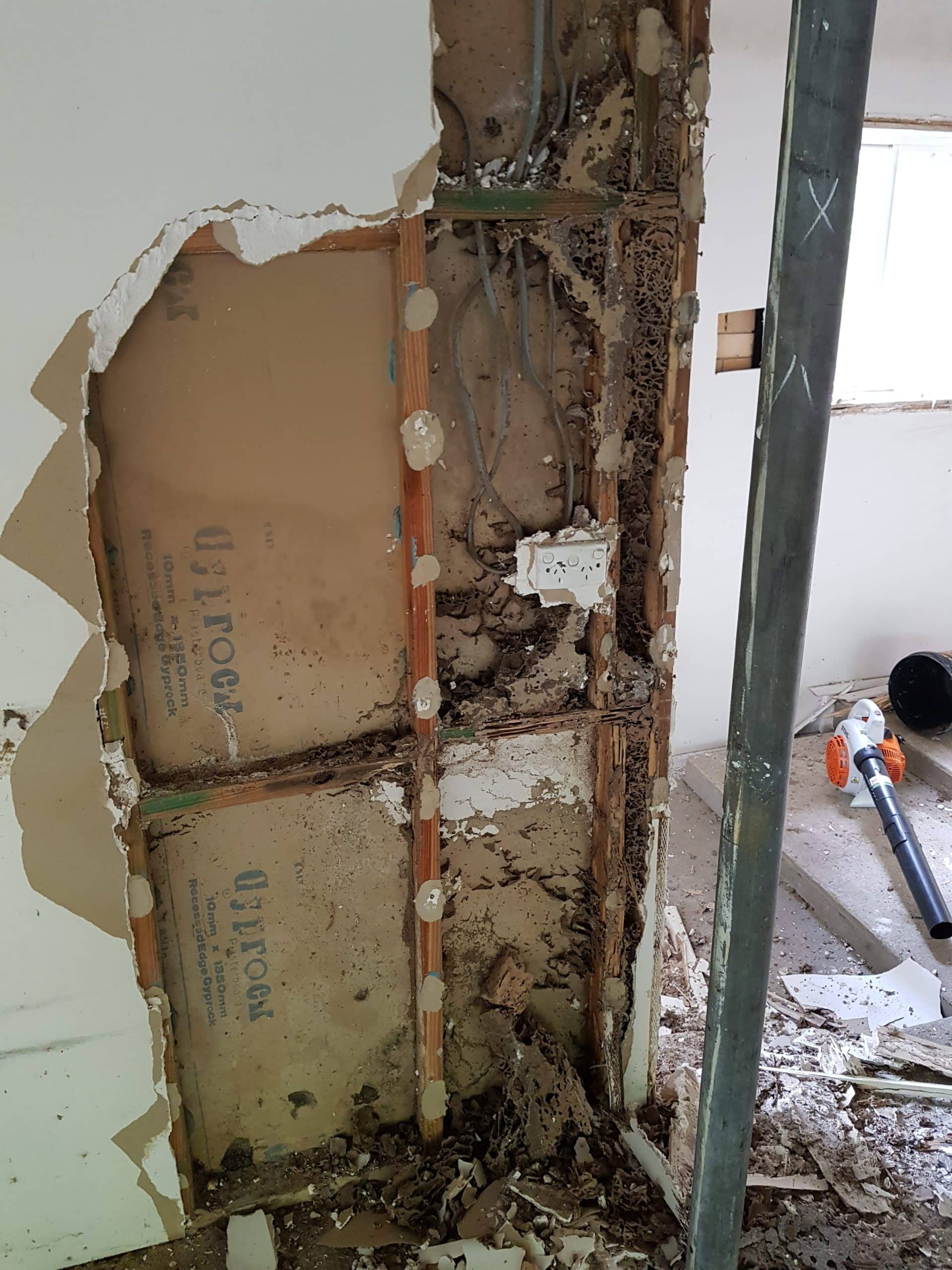
20 Dec Water Ingress in Floor to Wall Joint = White Ants Infestation
The poor property owners had no idea that their home was taking in water through the floor to wall joint resulting in a devastating pest invasion.
The leak was subtle, so no visual signs of excess moisture were noticed until it was too late and immense damage had been caused by the white ants. The timber frame was soaking up water like a sponge turning it into a big feast and a brilliant damp place for the white ants/termites to build multiple nests.
This passageway of water created an invitation for the white ants/termites to enter, colonise and destroy large areas of the home. When water seepage goes on undetected, the increased moisture level causes the wood fibres to soften. Water seepage/ingress can act as an open invitation to termite (white ants) infestation.
The softened wood fibres will, in turn, make it easier for the white ants/termites to chew through the cellulose in addition to providing the white ants with the source of water that they need to thrive.
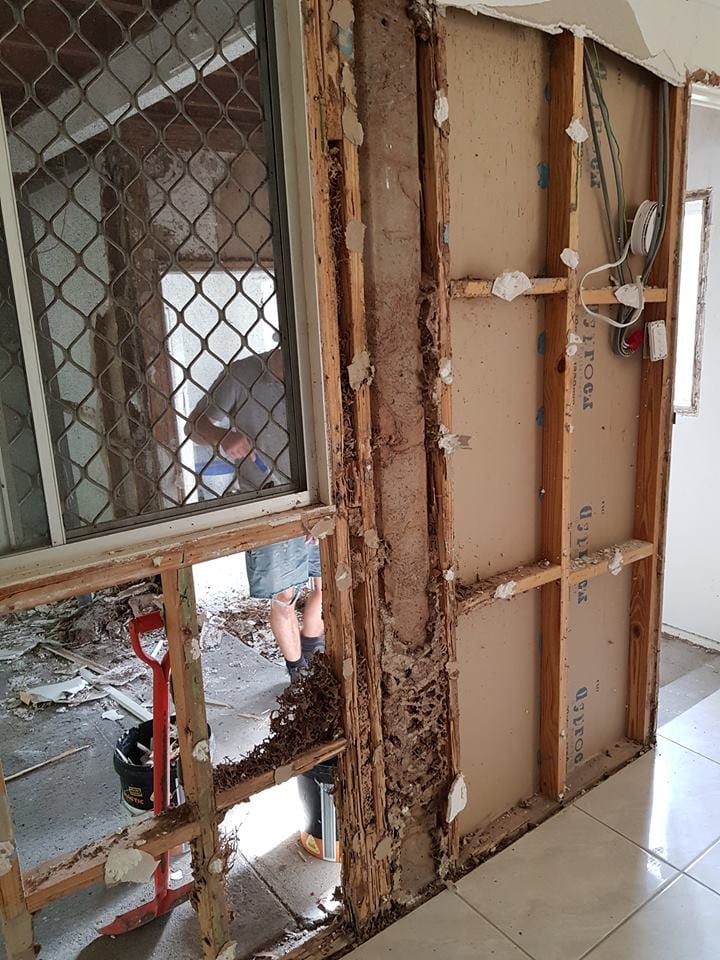
We really feel for these homeowners as insurance does not cover this. It is likely that almost the entire lower level of their home will need to be re-built due to the extent of the damage.
During our inspection of the property (with Waterstop’s thermal imaging camera and non-invasive penetrating moisture meters) with the client’s builder, we picked up an additional live nest and other activity missed by the pest inspector which isn’t surprising with the extent of the infestation.
In short, the lesson to take from this is it pays to perform regular pest inspections and be aware of any signs of moisture ingress especially into timber structures and to treat accordingly.
In particular, if your property is in a high-risk area, or is cut into the ground, more frequent and thorough inspections should be performed by a reputable pest and termite control professional.
Go for a walk around your property today to check that all your downpipes are in good working order and that the spouts are directed well away from the building.
Another thing to look for is that the ground surrounding your house is adequately graded away from the external walls to help ensure that rainwater is not pooling against the walls.
QBCC talks about what Termite Management is in their article here: https://www.qbcc.qld.gov.au/blog/home-property-owners/termite-attack
What are white ants?
White ants are in fact termites, a species more closely related to cockroaches. They just love moisture and soft wood such as timber framing. They are a highly destructive pest causing major structural timber damage to domestic and commercial buildings in Queensland.
Termites (white ants) are soft-bodied insects. They are sensitive to dehydration, so they stay out of the light as much as possible. When subterranean termites must travel in the open, they make protective dirt tunnels. However, termites can often find cracks to use as entryways into the home. This allows them to travel from the ground without being exposed.
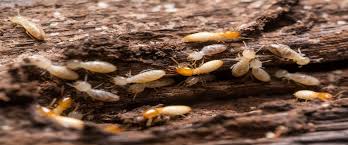
Image: In nature, termites are beneficial. They recycle fallen trees and other dead wood. However, when there are no fallen trees, termites often turn to the wood in homes for food.
I Live In A Brick Home So I Should Be Safe
There is a general perception that brick and tile houses are safe from termites. The fact is that a large number of brick houses in Queensland have timber wall and roof framing.
When termites (white ants) find a crack in the mortar between the bricks or a crack in the floor to wall joint, they use the crack as an entry point to get access to the timber framing.
Homeowners/property owners are encouraged to having their property inspected regularly. Termite control professionals can recognize the signs of termite activity. If treatment is necessary, they can prescribe the most effective treatment.
How To Close The Termite Entry Passage In The Floor To Wall Joint
Wall-floor joints in infill slabs often act as leakage points. This joint commonly work as a highway passage for water and is attracting the termites (white ants) by providing moisture and softened wood.
For the best outcome when water is entering the building through the wall to wall joint, we recommend injecting the floor/wall joint with a flexible polyurethane grout, which will create a deep flexible seal and stop water passing through the construction joint between the floor and the wall. The flexible seal will allow for some movement.
A reverse side/negative side waterproofing membrane or a protective coating (on the inside wall) may be applied to the affected walls creating an extra seal between the floor and the wall.
Demonstration Models As An Example For Illustration:
This model illustrates an infill slab that is joined with the wall
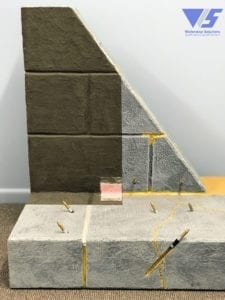
Waterstop Solutions Concrete Crack Injection:
10mm holes are drilled typically at 200mm intervals to intersect the crack or joint. Where holes are required through tiling, we can, as an added service, core-drill 20mm holes through the tiles prior to drilling the 10mm holes.
We insert high-pressure non- return injection ports into the holes, and then the injection process begins pumping the material into place to fill the targeted area.
We use the best injection product available offering superior performance benefits including permanent flexibility, very low shrinkage, water potable, low viscosity and a hydrophilic reaction.
The yellow line illustrates the deep seal between the wall and floor joint.
This model also illustrates other examples of deep sealing by injection of floor/wall joint and deep cracks in the floor and the wall.
The dark grey on the wall illustrates the negative side waterproofing membrane overlapping the floor/wall joint, creating an extra seal.
This image below illustrates typical water passage entry points in infill slab
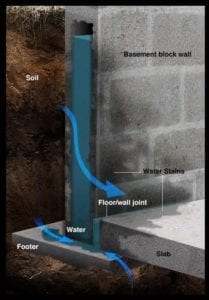
How water gets into your basement
A positive side waterproofing will not be capable of sealing and stopping water from passing through the construction joint between the floor and the wall.
However Waterstop Solutions proven injection methods in the floor/wall joint with a hydrophilic polyurethane resin, combined with reverse side/negative side membrane application to the affected walls will create a deep flexible seal and stop water passing through the block wall and the construction joint between the floor and the wall.
If you have any issues with water ingress, cracking concrete slabs, structural cracks, concrete deterioration, moisture, seepage, efflorescence, rising damp and/or high-flow active leaks in concrete structures, we would be happy to assist you. You are welcome to contact us with any questions that you may have.
Brisbane office: (07) 3205 1899
Email: [email protected]
Sydney office: 02 9346 8308
Email: [email protected]

